Athletes with prosthetic limbs push the limits of human potential, proving that limb loss does not mean the end of competitive sports. Whether sprinting, cycling, playing basketball, or engaging in high-impact activities, these athletes train hard to reach peak performance. However, using a prosthetic in sports requires special attention to injury prevention and physical conditioning.
A prosthetic limb is not just a replacement—it is a high-performance tool that needs to work in sync with the body. Proper training, conditioning, and injury prevention strategies are crucial to ensure smooth movement, reduce strain, and improve overall athletic ability. From muscle strengthening to prosthetic maintenance, every aspect of preparation plays a role in achieving success.
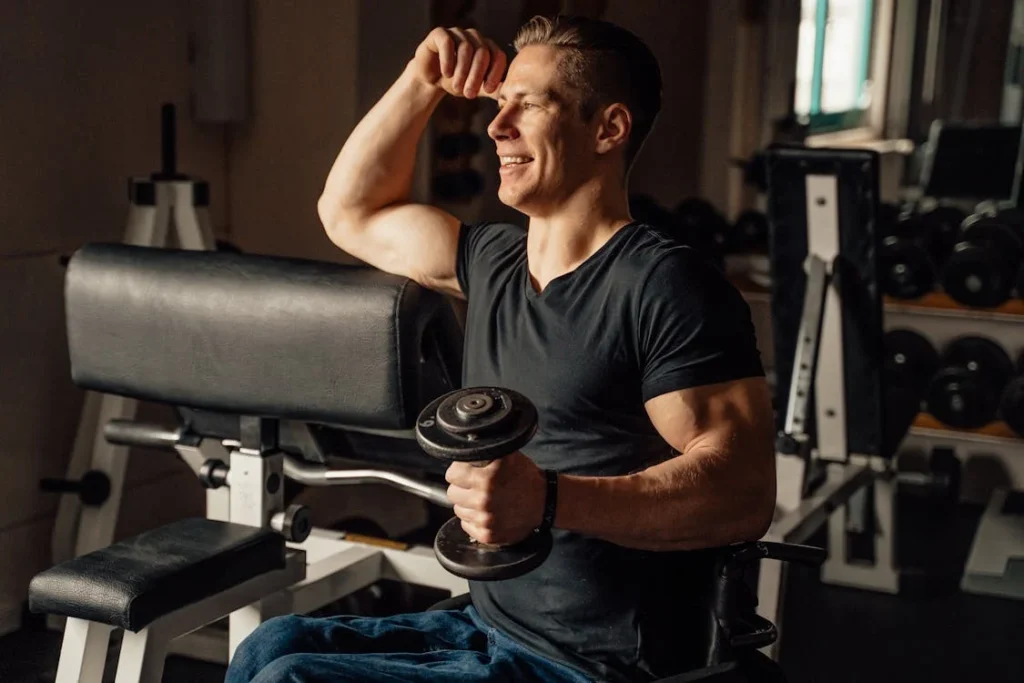
Strength Training to Prevent Injuries and Boost Performance
Athletes with prosthetic limbs rely on strength training to improve stability, endurance, and power. Unlike traditional training, they must focus on specific muscle groups that compensate for the missing limb and support the prosthetic.
A well-conditioned body ensures smoother movement, reduces fatigue, and minimizes the risk of injuries caused by muscle imbalances.
Building Core Strength for Stability
The core is the foundation of movement. It controls balance, posture, and force generation. For amputee athletes, a strong core is even more important because it helps maintain stability when running, jumping, or shifting weight.
Weak core muscles can lead to poor posture, uneven weight distribution, and strain on the residual limb.
Core exercises such as planks, leg raises, and rotational movements strengthen the abdominal and lower back muscles, allowing athletes to move with greater control. When the core is strong, the prosthetic limb moves more naturally, reducing stress on other parts of the body.
Strengthening the Supporting Muscles
Athletes using prosthetic legs must develop strength in the hips, glutes, and lower back to compensate for the missing limb’s movement.
These muscles provide power for sprinting, jumping, and sudden changes in direction. Weakness in these areas can lead to instability, improper gait, and a higher risk of injury.
For upper-limb amputees, the shoulders, chest, and remaining arm play a crucial role in maintaining balance and control. Strengthening these muscles improves performance in sports like basketball, cycling, and weightlifting, where upper-body endurance is essential.
By targeting these supporting muscles, athletes create a strong foundation that allows them to move with more confidence and efficiency.
Preventing Muscle Imbalances
One of the biggest challenges for athletes with prosthetics is avoiding muscle imbalances. Since the prosthetic side does not have active muscles, the opposite side may become overworked. This can lead to uneven strain on the body, causing pain or even long-term injuries.
Strength training should focus on both sides of the body, ensuring that one side does not become significantly stronger than the other.
Using resistance bands, free weights, and controlled bodyweight exercises helps maintain even muscle development and prevents unnecessary stress on joints.
Regular assessment by a physical therapist or coach can help athletes adjust their training to correct imbalances and optimize performance. By focusing on strength and stability, they can move more efficiently, reduce the risk of injuries, and enhance their overall athletic ability.
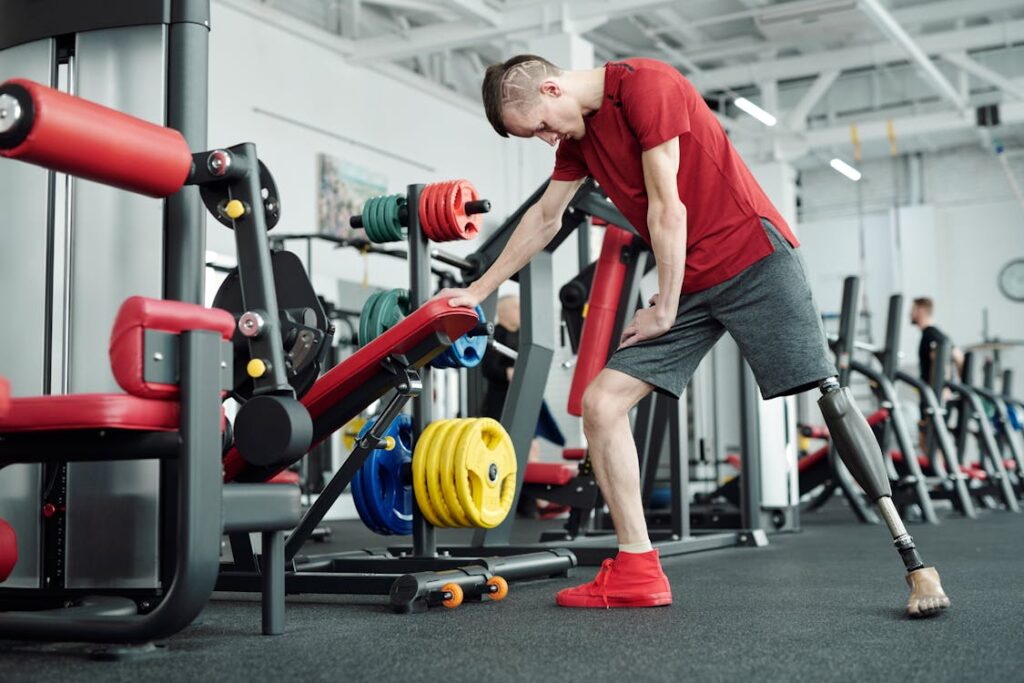
Optimizing Prosthetic Fit and Function for Injury Prevention
A well-fitted prosthetic is just as important as strength training when it comes to preventing injuries and enhancing performance.
Athletes put immense stress on their prosthetic limbs during high-impact activities, and even a small misalignment can lead to discomfort, strain, and potential injury.
Proper fit, alignment, and maintenance ensure that the prosthetic limb moves in harmony with the body, reducing unnecessary stress on muscles and joints.
The Importance of Proper Prosthetic Alignment
Prosthetic alignment affects everything from balance to movement efficiency. If a prosthetic knee or foot is slightly off in its positioning, it can create uneven weight distribution, leading to hip, knee, or back pain.
Athletes with lower-limb prosthetics must ensure that their socket fits snugly and that their knee and foot components are properly adjusted to match their gait.
For upper-limb athletes, the alignment of the prosthetic arm or hand plays a role in grip strength, shoulder stability, and control. A poorly aligned arm prosthetic can lead to overuse injuries in the remaining arm and back muscles.
Regular check-ups with a prosthetist ensure that adjustments are made based on changes in muscle development and training intensity.
Customization for Sport-Specific Movements
Athletes in different sports require different prosthetic setups. A sprinter needs a prosthetic leg that maximizes forward propulsion, while a rock climber needs a prosthetic with excellent grip and flexibility.
Customization allows athletes to fine-tune their prosthetic limbs to match their sport’s unique demands.
Some advanced prosthetic knees and feet come with adjustable settings that allow athletes to modify stiffness, resistance, and energy return. This level of customization helps prevent injuries by ensuring the prosthetic responds naturally to movement and impact.
For upper-limb amputees, customized attachments—such as grip-enhancing hands for weightlifting or flexible wrist joints for racket sports—allow for greater adaptability and performance.
By working closely with prosthetists and coaches, athletes can optimize their prosthetics to improve efficiency and reduce strain on their bodies.
Reducing Skin Irritation and Pressure Sores
One of the most common injury risks for amputee athletes is skin irritation or pressure sores caused by friction between the residual limb and the prosthetic socket.
Intense training sessions can lead to sweating, which increases the chances of chafing and discomfort. If left unaddressed, these issues can develop into painful sores that limit training and competition.
Using breathable liners, moisture-wicking materials, and ensuring proper socket fit can help reduce friction. Athletes should also check their skin daily for signs of redness or irritation and make adjustments to their prosthetic fit if needed.
Applying anti-friction creams and keeping the residual limb clean and dry further prevents irritation.
Routine Maintenance for Long-Term Performance
Like any high-performance equipment, prosthetic limbs require regular maintenance to function at their best. Loose joints, worn-out suspension systems, or damaged foot components can affect movement and increase the risk of falls or injuries.
Athletes should routinely inspect their prosthetic limbs for signs of wear and tear, ensuring that all parts are secure and functioning correctly.
A well-maintained prosthetic limb not only enhances performance but also ensures long-term safety. Regular servicing by a prosthetist and immediate adjustments to fit and alignment help athletes stay at their peak without unnecessary strain or risk of injury.
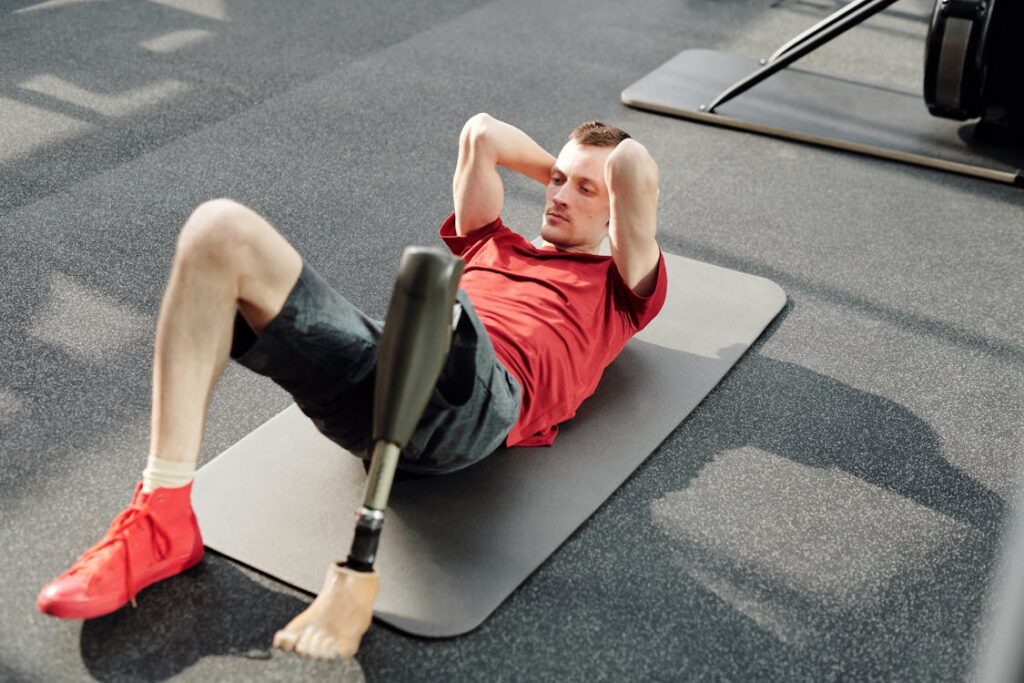
Enhancing Mobility and Agility Through Balance and Coordination Training
For athletes with prosthetic limbs, developing balance and coordination is essential to moving efficiently and preventing injuries.
Unlike able-bodied athletes, amputees must learn to control their movement with an artificial limb that does not provide natural sensory feedback. This requires targeted training to improve body awareness, agility, and reaction time.
Training the Body to Move Naturally
One of the biggest challenges for amputee athletes is achieving natural movement patterns. When using a prosthetic, the body must compensate for the lack of muscle control in the artificial limb.
Without proper training, this can lead to inefficient movement and unnecessary strain on other body parts.
Balance training helps athletes develop better control over their weight distribution, allowing for smoother transitions between movements.
Exercises such as single-leg stands, weight shifts, and controlled stepping drills teach the body how to adapt to the prosthetic limb’s mechanics. Over time, these exercises improve stability and confidence in movement.
For upper-limb amputees, coordination drills that focus on hand-eye control, grip adjustments, and reaction speed enhance their ability to use their prosthetic arm naturally.
Activities like catching and throwing, resistance band exercises, and fine motor skill training help improve overall dexterity and control.
Improving Agility for High-Intensity Sports
Agility is crucial for sports that require quick direction changes, sudden stops, and fast reactions. Amputee athletes must train their bodies to move efficiently while adjusting to the unique biomechanics of their prosthetic limbs.
Agility ladder drills, cone drills, and quick footwork exercises help athletes develop faster reaction times and smoother transitions between movements. These exercises not only enhance sports performance but also reduce the risk of falls and missteps that can lead to injuries.
For sports that require explosive power, such as sprinting or basketball, plyometric training helps improve coordination between the prosthetic limb and the rest of the body.
Jump training, bounding exercises, and controlled landings strengthen the muscles that support the prosthetic, ensuring that movements are both powerful and safe.
Developing Proprioception for Better Body Awareness
Proprioception is the body’s ability to sense movement and position without visual feedback. For amputees, developing proprioception is vital because the prosthetic limb does not provide the same sensory feedback as a natural limb.
Athletes must rely on their remaining muscles, core stability, and visual awareness to maintain control.
Balance boards, stability balls, and uneven surface training force the body to make small adjustments in real time, improving coordination and reducing the likelihood of missteps.
Athletes who engage in regular proprioception training gain better control over their prosthetic limb, allowing for more fluid and confident movement.
As mobility and agility improve, athletes find it easier to perform complex movements, react quickly in game situations, and avoid injuries caused by instability or poor coordination.
These training techniques are essential for reaching peak performance while staying safe and efficient in motion.
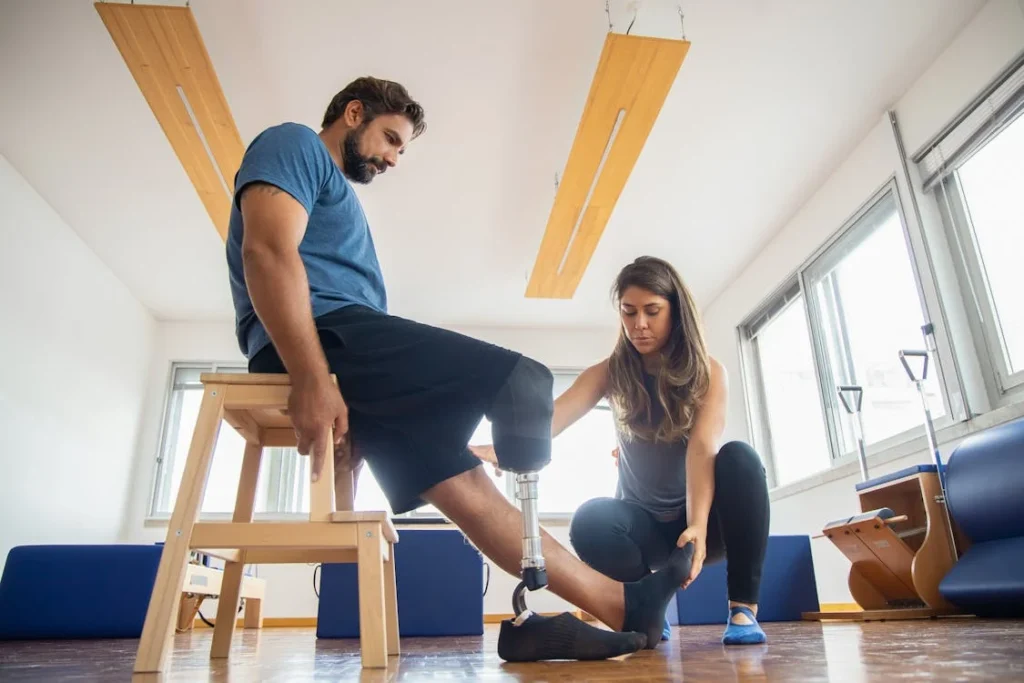
Recovery and Injury Management for Prosthetic Athletes
Training hard and competing at a high level puts significant strain on the body, making recovery an essential part of an athlete’s routine.
For athletes with prosthetic limbs, recovery is even more critical, as their bodies must adjust to additional physical stress, maintain muscle balance, and prevent overuse injuries. A well-structured recovery plan not only reduces injury risk but also improves long-term performance.
Managing Overuse Injuries and Muscle Fatigue
Athletes using prosthetics often rely more heavily on certain muscle groups to compensate for the missing limb. Over time, this can lead to muscle fatigue, joint stiffness, and even overuse injuries.
The most commonly affected areas include the lower back, hips, shoulders, and the remaining limb.
To prevent overuse injuries, athletes must incorporate rest days, stretching routines, and active recovery sessions into their training plans.
Foam rolling, massage therapy, and mobility exercises help release muscle tension and improve flexibility, ensuring that the body remains in optimal condition.
For lower-limb amputees, hip and lower back strain is a common issue due to altered weight distribution. Gentle stretching of the hip flexors, hamstrings, and lower back can prevent tightness and discomfort.
Upper-limb amputees benefit from shoulder and upper back mobility work to avoid stiffness from repeated prosthetic use.
The Role of Physical Therapy in Injury Prevention
Regular sessions with a physical therapist help athletes maintain proper movement mechanics and address any alignment issues before they become serious injuries.
Physical therapists assess posture, gait, and muscle imbalances to ensure that training movements do not place excessive strain on the body.
For athletes recovering from minor injuries, rehabilitation exercises help rebuild strength and restore full range of motion. These exercises focus on gradually reintroducing movement patterns while ensuring that the prosthetic limb remains well-aligned with the rest of the body.
Hydrotherapy is another excellent recovery tool for amputee athletes. Water-based exercises reduce impact on joints while allowing for full-body movement. This method is particularly useful for post-injury rehabilitation and active recovery sessions.
Nutrition and Hydration for Faster Recovery
Proper nutrition plays a crucial role in an athlete’s ability to recover from intense training sessions. Protein-rich foods support muscle repair, while anti-inflammatory foods, such as fruits, vegetables, and omega-3-rich sources, help reduce soreness and joint stiffness.
Hydration is just as important, especially for athletes who sweat heavily during training. Dehydration can lead to muscle cramps, fatigue, and slower recovery times.
Drinking enough water, combined with electrolyte-rich fluids, ensures that the body remains well-hydrated and ready for the next training session.
Sleep and Mental Recovery for Peak Performance
Athletes often focus on physical recovery, but mental recovery is just as important. Competitive sports require intense concentration and focus, and overtraining can lead to mental fatigue.
Getting enough sleep is essential for muscle repair, hormone regulation, and overall athletic performance.
Mindfulness techniques, meditation, and deep breathing exercises help reduce stress and improve mental clarity. Athletes who incorporate these practices into their routine are better equipped to handle the pressures of competition and maintain a strong, focused mindset.
By prioritizing recovery and injury management, athletes with prosthetic limbs can extend their careers, stay injury-free, and perform at their highest potential. Taking the time to rest and restore the body ensures long-term success in any sport.
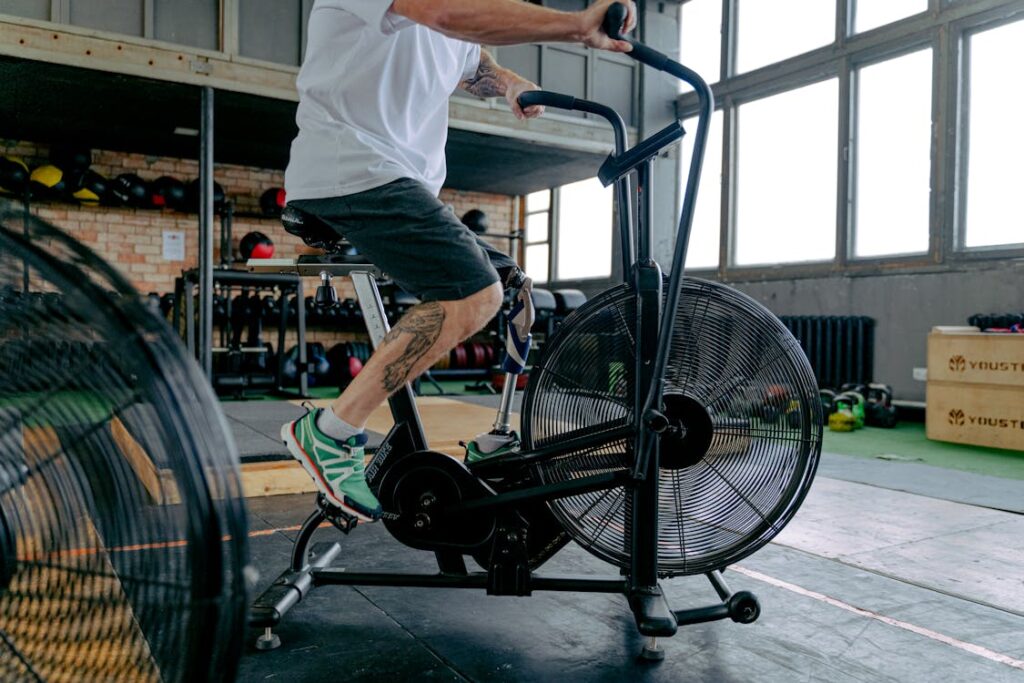
The Psychological Edge: Mental Toughness and Confidence in Sports
Athletic success is not just about physical strength and endurance—it is also about mental resilience. Athletes with prosthetic limbs face unique psychological challenges, from overcoming self-doubt to handling the pressures of competition.
Developing mental toughness is key to staying motivated, confident, and focused on performance goals.
Overcoming Self-Doubt and Building Confidence
For many amputee athletes, the biggest challenge is not physical—it is believing in their ability to compete at the highest level. Whether returning to sports after an amputation or entering a new level of competition, self-doubt can be a major barrier.
One of the most effective ways to build confidence is through gradual progression. Setting small, achievable goals allows athletes to track their improvement and recognize their capabilities.
Each milestone—whether it’s running a faster sprint, jumping higher, or mastering a new technique—reinforces confidence and proves that limitations can be overcome.
Support from teammates, coaches, and other adaptive athletes plays a crucial role in building self-assurance. Being surrounded by a positive community that understands the challenges of using a prosthetic in sports helps athletes stay motivated and push past their mental barriers.
Handling Pressure and Staying Focused
Competitive sports come with pressure—whether it’s the pressure to perform well, meet expectations, or recover from setbacks. Athletes with prosthetics must learn to manage stress effectively so that it does not interfere with performance.
Visualization techniques are a powerful tool for mental preparation. By mentally rehearsing movements and strategies before a game or race, athletes can improve focus and execution. Visualization helps reinforce muscle memory, making actions feel more natural and automatic.
Breathing techniques also help manage stress and maintain composure. Deep, controlled breathing activates the body’s relaxation response, reducing anxiety and improving concentration.
This technique is especially useful before high-pressure moments, such as the start of a race or a critical play in a game.
Developing a Growth Mindset
A growth mindset—the belief that ability can be developed through effort and persistence—is essential for long-term success. Instead of viewing challenges as obstacles, athletes with a growth mindset see them as opportunities to improve.
For prosthetic athletes, setbacks such as adjusting to a new prosthetic limb, recovering from an injury, or losing a competition should be viewed as part of the learning process.
Those who stay committed to improvement, despite difficulties, ultimately become stronger both mentally and physically.
Learning from other adaptive athletes can be inspiring and motivating. Watching Paralympic athletes, speaking with experienced competitors, and hearing stories of perseverance remind athletes that success is possible with dedication and the right mindset.
The Role of Sports Psychology in Performance
Many high-level athletes, including those with prosthetics, work with sports psychologists to enhance their mental game. Sports psychology focuses on developing strategies for handling competition pressure, staying motivated, and bouncing back from setbacks.
Techniques such as cognitive reframing—changing negative thoughts into positive ones—help athletes stay in the right mindset.
Instead of thinking, “I can’t compete at this level,” an athlete learns to say, “I’m improving with every training session.” This mental shift strengthens confidence and resilience.
By focusing on mental strength alongside physical training, athletes with prosthetic limbs can maximize their potential, stay motivated, and compete with the same level of intensity and determination as any other athlete.
Developing psychological resilience ensures that they not only perform at their best but also enjoy the journey of sports and competition.
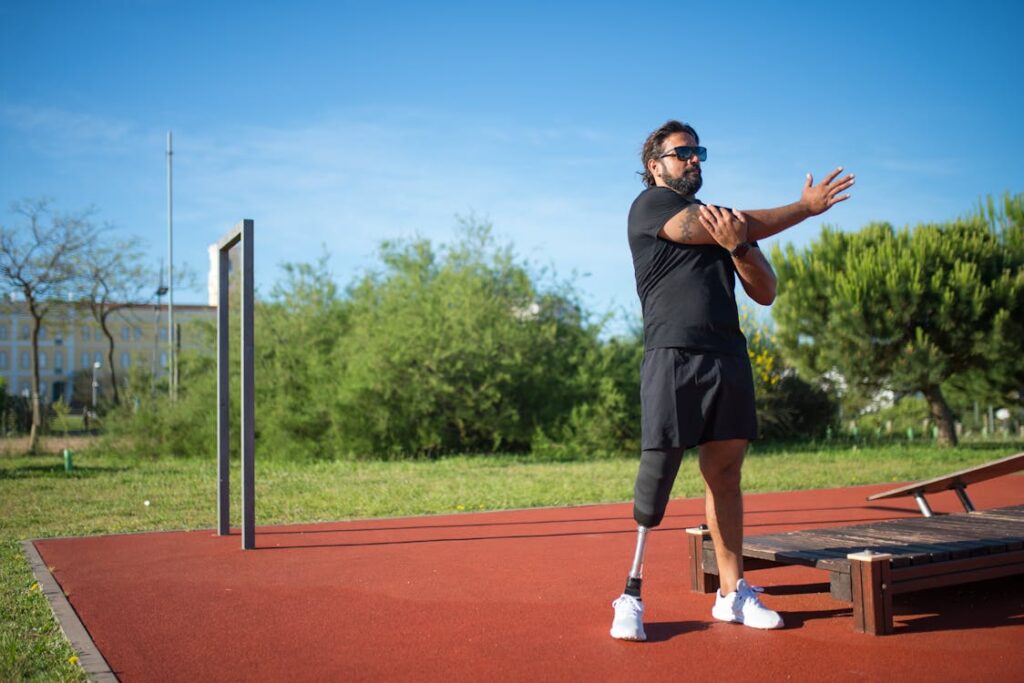
The Role of Technology in Enhancing Performance and Injury Prevention
Advancements in prosthetic technology have transformed the way amputee athletes train, compete, and recover.
Modern prosthetic limbs are no longer just replacements for lost limbs—they are high-performance tools designed to enhance mobility, optimize energy efficiency, and reduce injury risks.
The integration of cutting-edge materials, smart technology, and biomechanical engineering has allowed athletes to push their limits like never before.
Smart Prosthetics: Real-Time Adaptation for Better Performance
One of the most significant innovations in sports prosthetics is the development of microprocessor-controlled prosthetic knees and feet.
These smart devices use sensors to analyze movement patterns in real time, adjusting resistance, shock absorption, and stability based on the athlete’s activity.
For example, a microprocessor knee can detect when an athlete is sprinting and adjust its mechanics to provide smoother transitions between strides.
It can also sense when the user is landing from a jump and increase resistance to absorb impact, reducing strain on the residual limb.
Some of the most advanced prosthetics even include artificial intelligence (AI) algorithms that learn an athlete’s movement style over time. These AI-driven systems fine-tune performance automatically, making each motion more natural and efficient.
Energy-Storing and Energy-Returning Prosthetics
Athletes require powerful, explosive movements for jumping, sprinting, and agility-based sports. Traditional prosthetic limbs were often rigid and limited in motion, but today’s designs incorporate energy-storing materials like carbon fiber to create a more dynamic response.
Energy-returning prosthetic feet and knees absorb force when the athlete steps or lands and then release that energy to propel them forward.
This technology mimics the natural elasticity of muscles and tendons, allowing for greater speed, higher jumps, and reduced energy expenditure.
For long-distance runners, energy-efficient prosthetics help conserve strength, allowing them to maintain endurance over extended periods. For jumpers, the added propulsion reduces strain on the joints and muscles, making landings smoother and safer.
Lightweight Materials for Increased Agility
The weight of a prosthetic limb can significantly impact an athlete’s performance.
Traditional prosthetics were often made from heavier metals, but today’s high-performance limbs use lightweight materials such as titanium, aerospace-grade aluminum, and carbon fiber composites.
These materials not only reduce overall weight but also improve strength and durability. A lighter prosthetic allows for faster movement, better control, and reduced fatigue, especially in sports requiring rapid footwork or explosive jumps.
Customization and 3D Printing in Prosthetic Sports
Every athlete has different needs based on their sport, body type, and movement patterns. Custom prosthetic design plays a huge role in ensuring optimal performance and injury prevention.
Modern 3D printing technology allows for prosthetic limbs to be precisely tailored to an individual’s unique biomechanics.
With 3D printing, manufacturers can create custom sockets, footplates, and knee components that fit perfectly and reduce pressure points. This minimizes discomfort and prevents common issues like skin irritation and misalignment-related injuries.
Athletes can also choose specific stiffness levels, flexibility settings, and shock absorption capacities, ensuring that their prosthetic limb meets the exact demands of their sport.
Whether a cyclist needs a low-resistance knee for continuous pedaling or a sprinter requires a footplate with maximum energy return, custom prosthetics enhance performance and safety.
Wearable Sensors and Performance Tracking
Athletes rely on data to fine-tune their performance, and prosthetic technology is evolving to meet this need. Wearable sensors and smart tracking systems now allow amputee athletes to monitor their gait, impact force, stride length, and balance.
These sensors provide real-time feedback, helping athletes identify movement inefficiencies and areas for improvement. If an athlete notices excessive pressure on one side of the body, adjustments can be made to prevent overuse injuries.
Coaches and prosthetists can also use this data to make precise modifications to prosthetic alignment and settings.
The Future of Prosthetic Innovation in Sports
As technology continues to advance, the future of prosthetic sports performance looks even more promising.
Researchers are developing bionic limbs with neural integration, allowing prosthetic limbs to be controlled by the brain, creating a near-instant response time. This could revolutionize the way amputee athletes move, providing an even closer replication of natural motion.
Other emerging technologies, such as self-adjusting hydraulic systems and smart materials that change stiffness based on movement, will continue to enhance agility, reduce strain, and improve overall comfort.
With each breakthrough, prosthetic technology is closing the gap between artificial limbs and natural human movement.
These innovations allow amputee athletes to not only compete at the highest level but also train more safely, recover more efficiently, and prevent injuries before they happen.
Conclusion
Athletes with prosthetic limbs are redefining the limits of human performance, proving that adaptability, training, and technology can overcome physical barriers. By focusing on strength, balance, and agility, they enhance movement efficiency while reducing injury risks. A well-fitted prosthetic, combined with sport-specific training, allows them to compete safely and effectively.
Advancements in prosthetic technology, from microprocessor-controlled knees to energy-returning feet, have revolutionized the way amputee athletes train and perform. Customization, lightweight materials, and smart tracking systems further optimize movement, ensuring peak performance with reduced strain on the body.
Beyond physical training, mental resilience plays a crucial role in success. Confidence, focus, and a strong mindset allow athletes to push through challenges and stay competitive. With proper recovery strategies, physical therapy, and personalized prosthetic adjustments, they can extend their careers while staying injury-free.
At Robobionics, we believe that technology and innovation should empower athletes to move without limits. Whether you’re a professional competitor or an active individual, the right prosthetic can help you achieve your goals. Book a consultation today to find the best prosthetic solution for your sport and take your performance to the next level!



